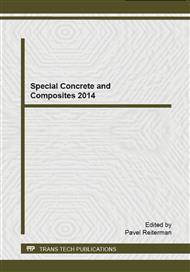[1]
V. M. Malhotra. High-performance high-volume fly ash concrete. Concrete International, 24(7), (2002).
Google Scholar
[2]
P. Kumar Mehta. High-performance, high-volume fly ash concrete for sustainable development. In Proceedings of the international workshop on sustainable development and concrete technology, pages 3-14, (2004).
Google Scholar
[3]
J.J. Hycnar. Czynniki wpływające na właściwości fizykochemiczne i użytkowe stałych produktów spalania paliw w paleniskach fluidalnych: monografia. Wydawnictwo Górnicze, (2006).
Google Scholar
[4]
M.A. Glinicki and M. Zieliński. The influence of CFBC fly ash addition on phase composition of air-entrained concrete. Bulletin of the Polish Academy of Sciences. Technical Sciences, 56(1): 45- -52, (2008).
Google Scholar
[5]
D. Jóźwiak-Niedźwiedzka. Effect of fluidized bed combustion fly ash on the chloride resistance and scaling resistance of concrete. Concrete in Aggressive Aqueous Environments, Performance, Testing and Modeling, pages 2-5, (2009).
Google Scholar
[6]
W. Kubissa, I. Wilińska, and M Pałuba. Badanie właściwości betonów cementowych wykonanych z udziałem odpadów przemysłowych. Przegląd Budowlany, 84: 35-39, (2013).
Google Scholar
[7]
A. Weir. Vancouver's winter olympics go for green. Ash at Work, 1: 26-31, (2010).
Google Scholar
[8]
M.A. Glinicki. Tendencje rozwojowe technologii betonu. Przeglad Budowlany, 78: 24-30, (2007).
Google Scholar
[9]
L. Czarnecki and W. Kurdowski. Tendencje kształtujace przyszłość betonu. Budownictwo, Technologie, Architektura, nr 1: 50-55, (2007).
Google Scholar
[10]
A. Bentur, A. Katz, and S. Mindess. Przyszłość betonu. Wizja i wyzwania. Cement Wapno Beton, 11: 102-121, (2006).
Google Scholar
[11]
A. Ajdukiewicz. Aspekty trwałości i wpływu na środowisko w projektowaniu konstrukcji betonowych. Przegląd Budowlany, 82: 20-29, (2011).
Google Scholar
[12]
P. Nath and P. Sarker. Effect of fly ash on the durability properties of high strength concrete. Procedia Engineering, 14: 1149-1156, (2011).
DOI: 10.1016/j.proeng.2011.07.144
Google Scholar
[13]
M.J. McCarthy and R.K. Dhir. Development of high volume fly ash cements for use in concrete construction. Fuel, 84(11): 1423-1432, (2005).
DOI: 10.1016/j.fuel.2004.08.029
Google Scholar
[14]
P. Chindaprasirt, C. Chotithanorm, H.T. Cao, and V. Sirivivatnanon. Influence of fly ash fineness on the chloride penetration of concrete. C. and Building Materials, 21(2): 356-361, (2007).
DOI: 10.1016/j.conbuildmat.2005.08.010
Google Scholar
[15]
W. Kubissa and R. Jaskulski. Measuring and time variability of the sorptivity of concrete. Procedia Engineering, 57: 634-641, 2013. Modern Building Materials, Structures and Techniques.
DOI: 10.1016/j.proeng.2013.04.080
Google Scholar
[16]
S. Kou, C. Poon, and F. Agrela. Comparisons of natural and recycled aggregate concretes prepared with the addition of different mineral admixtures. Cement and Concrete Composites, 33(8): 788-795, (2011).
DOI: 10.1016/j.cemconcomp.2011.05.009
Google Scholar
[17]
T. Nochaiya, W. Wongkeo, and A. Chaipanich. Utilization of fly ash with silica fume and properties of portland cement fly ash silica fume concrete. Fuel, 89(3): 768-774, (2010).
DOI: 10.1016/j.fuel.2009.10.003
Google Scholar
[18]
M.K. Gopalan. Sorptivity of fly ash concretes. Cement and Concrete Research, 26(8): 1189- 1197, (1996).
DOI: 10.1016/0008-8846(96)00105-6
Google Scholar
[19]
M. Mazloom, A.A. Ramezanianpour, and J.J. Brooks. Effect of silica fume on mechanical properties of high-strength concrete. Cement and Concrete Composites, 26(4): 347-357, (2004).
DOI: 10.1016/s0958-9465(03)00017-9
Google Scholar
[20]
R. Duval and E. H Kadri. Influence of silica fume on the workability and the compressive strength of high-performance concretes. Cement and Concrete Research, 28(4): 533-547, (1998).
DOI: 10.1016/s0008-8846(98)00010-6
Google Scholar
[21]
B.B. Sabir. Mechanical properties and frost resistance of silica fume concrete. Cement and Concrete Composites, 19(4): 285-294, (1997).
DOI: 10.1016/s0958-9465(97)00020-6
Google Scholar
[22]
K. Turk, M. Karatas, and T. Gonen. Effect of fly ash and silica fume on compressive strength, sorptivity and carbonation of scc. KSCE Journal of Civil Engineering, 17(1): 202-209, (2013).
DOI: 10.1007/s12205-013-1680-3
Google Scholar
[23]
C.S. Poon, S.C. Kou, and L. Lam. Compressive strength, chloride diffusivity and pore structure of high performance metakaolin and silica fume concrete. Construction and Building Materials, 20(10): 858-865, (2006).
DOI: 10.1016/j.conbuildmat.2005.07.001
Google Scholar
[24]
U. Mucteba and A. Veysel. Durability performance of concrete incorporating Class F and Class C fly ashes. Construction and Building Materials, 34(0): 170-178, (2012).
DOI: 10.1016/j.conbuildmat.2012.02.075
Google Scholar
[25]
D. Jóźwiak-Niedźwiedzka. Estimation of chloride migration coefficient in air-entrained concretes containing fluidized bed combustion fly ash. ARCHIVES OF CIVIL ENGINEERING, LVIII(1): 25-38, (2012).
DOI: 10.2478/v.10169-012-0002-3
Google Scholar
[26]
M. Vieira, I.R. de Almeida, and A.F. Goncalves. Influence of moisture curing on durability of fly ash concrete for road pavements. ACI Special Publication, 192, (2000).
DOI: 10.14359/5743
Google Scholar
[27]
B. Pacewska, G. Blonkowski, and I. Wilińska. Studies on the pozzolanic and hydraulic properties of fly ashes in model systems. Journal of Thermal Analysis and Calorimetry, 94(2): 469-476, (2008).
DOI: 10.1007/s10973-008-9179-8
Google Scholar
[28]
B. Pacewska, G. Blonkowski, and I. Wilińska. Investigations of the influence of different fly ashes on cement hydration. Journal of Thermal Analysis and Calorimetry, 86(1): 179-186, (2006).
DOI: 10.1007/s10673-005-7136-7
Google Scholar
[29]
B.D. Ikotun and S. Ekolu. Strength and durability effect of modified zeolite additive on concrete properties. Construction and Building Materials, 24(5): 749-757, (2010).
DOI: 10.1016/j.conbuildmat.2009.10.033
Google Scholar
[30]
P.A.M. Basheer. Permeation analysis. Handbook of analytical techniques in concrete science and technology, pages 658-737, (2001).
DOI: 10.1016/b978-081551437-4.50019-9
Google Scholar
[31]
D.F. Aponte, M. Barra, and E. Vàzquez. Durability and cementing efficiency of fly ash in concretes. Construction and Building Materials, 30: 537-546, (2012).
DOI: 10.1016/j.conbuildmat.2011.12.026
Google Scholar
[32]
A.R. Boğa and İ.B. Topçu. Influence of fly ash on corrosion resistance and chloride ion permeability of concrete. Construction and Building Materials, 31: 258-264, (2012).
DOI: 10.1016/j.conbuildmat.2011.12.106
Google Scholar


